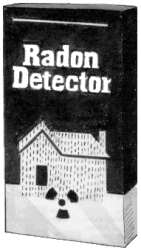Office of Air and Radiation (6601)
EPA Document #520/1-89-027
September 1992REDUCING RADON RISKS
There are two ways to protect your
family from Radon.
First, the hard way
Holding Your BreathTest Your Home For Radon.
Your Family Will Breathe A Lot Easier.
With every breath, your family could be exposing themselves to a radioactive gas called radon. It's impossible to see, smell or taste. And it could be accumulating to unsafe levels in your home right now.
Radon is found at high levels in every state in America. It seeps into your home from the surrounding soil, and sometimes contaminates well water. It's the second leading cause of lung cancer in the U.S.- only cigarette smoking causes more lung cancer deaths. In fact, the Environmental Protection Agency and the Surgeon General have strongly recommended that all residences (except those above the second floor in multi-level buildings) be tested for radon.
Your family's risk of developing lung cancer from radon depends on the average annual level of radon in your home and the amount of time you spend there. The longer your exposure to radon, the greater the risk. And the risk is much greater for smokers.
Luckily, radon is easy and inexpensive to detect. And homes with high levels can be fixed. But it's up to you to find out whether radon is a problem in your home. Millions of people have tested their homes already.
Testing Is Easy And Inexpensive.
Because radon is completely invisible to sight, smell or taste, special detection kits are necessary to find a potential problem.
Radon detection kits are inexpensive and easy to use. You can purchase a kit at your local hardware store or other retail outlets. Contact your state radon office, local American Lung Association
or contact a radon professional for more information on where to purchase a test kit.
After you've completed testing your home you simply mail the entire kit to the manufacturer for analysis (analysis is often included in the price of the kit). You can choose either a short-term or a long-term testing kit.
Short-term Testing Is The Quickest Way To Determine If A Potential Radon Problem Exists.
Short-term testing takes anywhere from a few days to several months to complete. The most common testing devices on the market right now are charcoal canisters, electret ion detectors and alpha track detectors. Short-term testing should be conducted in the lowest living area of your home, with the doors and windows shut, during the cooler months of the year.
Long-term Testing Is The Most Accurate Way To Test For Radon.
Long-term testing can take up to a full year. Alpha track detectors and electret ion detectors are the most common long term testing devices.
When you buy your kit, be sure to look for a test kit from a company that has successfully completed the EPA Radon Measurement Proficiency (RMP) Program [Now the National Radon Proficiency Program (RPP)]. Most companies indicate their test kit meets EPA requirements on the test kit box. State Radon offices also have a list of all radon measurement companies that meet state or EPA requirements.
For More Information
Most test kits contain further information about testing. If your house does need to be fixed, you'll get additional information along with your test results. And when you have tested, pass this information on to your neighbor. But please be sure to test for radon as soon as you can. And you'll all breathe a lot easier.
Radon
Contributes to
Thousands of
Deaths
Each Year.Now the Easy Way.
Use One of These.
Common Myths About Radon
MYTH: Scientists are not sure that radon really is a problem.
FACT: Although some scientists dispute the precise number of deaths due to radon, all the major health organizations (like the Centers for Disease Control and Prevention, the American Lung Association and the American Medical Association) agree with estimates that radon causes thousands of preventable lung cancer deaths every year. This is especially true among smokers, since the risk to smokers is much greater than to non-smokers.
MYTH: Radon testing devices are not reliable and are difficult to find.
FACT: Radon testing can be conducted by a professionally trained EPA-listed or state-certified radon tester.
Active radon devices can continuously gather and periodically record radon levels to reveal any unusual swings in the radon level during the test.
Reliable testing devices are also available through the mail, in hardware stores and other retail outlets. Call your state radon office for a list of radon device companies that have met EPA requirements for reliability or are state-certified.MYTH: Radon testing is difficult and time-consuming.
FACT: Radon testing is easy. You can test your own home or you can hire an EPA-listed or state-certified radon tester. Either approach takes only a small amount of the homeowner's time or effort.
MYTH: Homes with radon problems cannot be fixed.
FACT: There are solutions to radon problems in homes. Thousands of home owners have already lowered elevated radon levels in their homes. Radon levels can be readily lowered for $500 to $2,500. Call your state radon office for a list of contractors that have met EPA requirements or are state-certified.
MYTH: Radon affects only certain types of homes.
FACT: Radon can be a problem in all types of homes such as old homes, new homes, drafty homes, insulated homes, homes with basements and homes without basements. Construction materials and the way the home has been built may also affect radon levels.
MYTH: Radon is only a problem in certain parts of the country.
FACT: High radon levels have been found in every state. Radon problems do vary from area to area, but the only way to know the home's radon level is to test.
MYTH: A neighbor's test result is a good indication of whether your home has a radon problem.
FACT: It is not. Radon levels vary from home to home. The only way to know if your home has a radon problem is to test it.
MYTH: Everyone should test his or her water for radon.
FACT: While radon gets into some homes through the water, it is important to first test the air in the home for radon. If high radon levels are found and the home has a well, you can find publications and documents developed by EPA's Office of Ground Water and Drinking Water relating to radon in drinking water and the radon in drinking water rule at http://www.epa.gov/safewater/radon.html.
MYTH: It is difficult to sell a home where radon problems have been discovered.
FACT: Where radon problems have been fixed, home sales have not been blocked. The added protection could be a good selling point.
MYTH: I have lived in my home for so long, it does not make sense to take action now.
FACT: You will reduce your risk of lung cancer when you reduce radon levels, even if you have lived with a radon problem for a long time.
MYTH: Short-term tests cannot be used for making a decision about whether to reduce the home's high radon levels.
FACT: Short-term tests may be used to decide whether to reduce the home's high radon levels. However, the closer the short-term testing result is to 4 pCi/L, the less certainty there is about whether the home's year-round average is above or below that level. Keep in mind that radon levels below 4 pCi/L still pose some risk and that radon levels can be reduced in some homes to 2 pCi/L or below.
If you have further questions about radon, call your State radon contact or the Radon Infoline at 1 800/SOS-RADON.
If you have tested your home and found elevated levels of Radon, contact our Radon Fix-it Program: 1 800-644-6999
For sale by the Superintendent of Documents, U.S. Government Printing Office, Washington, DC 20402.
Last Modified: February 16, 1999
http://www.epa.gov/iaq/radon/pubs/rducrsks.html


